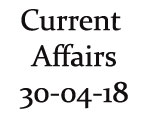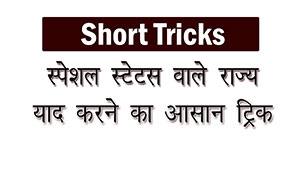-
Current Affairs 30th April 2018
Updated : 30-Apr-2018
Current Affairs 30th April 2018 - Important Points
- India-China Informal Summit held in Wuhan on - April 27-28th 2018
- Acquisition of NAG Missile System for Army and long range guns for Navy approved by - DAC
- Gujarati poet Sitanshu Yashaschandra chosen for - Saraswati Samman 2017
- International Buddhist Conference held in Lumbini, Nepal on - 29-30th April 2018
- External borrowing norms to enable cheaper funds eased by - RBI
- Derby air- to-air beyond visual range missile test fired by - LCA Tejas
Current Affairs 30th April 2018 - Details
India-China Informal Summit held in Wuhan on - April 27-28th 2018
The first Casual Summit between PM Narendra Modi and China’s President Xi Jinping was organised in Wuhan. The motive of meeting was to inter-change opinions on overarching issues of bilateral and international importance and to extravagant their respective dreams and priorities for national development in situation of present and future international situation.
Key Takeaway from the meeting- Both leaders approved that simultaneous emergence of India and China as 2 mega economies and major powers has suggestions of regional as well as global meaning. The peaceful, steady and well-adjusted ties among them will be optimistic factor for stability amidst present global uncertainties.
- They approved proper management of bilateral ties for conducive development and wealth of region.
- They finalised to fortify Closer Development Partnership in mutually beneficial and sustainable way.
- They also arranged to release strategic directions to their forces and fortify present mechanisms to
preserve peace and tranquillity along with the border parts is larger interest of the overall progress of bilateral relations. - Prime Minister Narendra Modi specially emphasis on reputation of people-to- people contact
through STRENGTH; which is S-Spirituality; T-Tradition, Trade and Technology; R-Relationship; E-
Entertainment; N-Nature conservation; G-Games; T-Tourism and H-Health and Healing. - Chinese President Xi organised that 2 nations should stand for multi-polar world order and globalisation.
- He detained that China and India are both significant engines for global development and they central pillars for encouraging multi-polar and globalised world.
Acquisition of NAG Missile System for Army and long range guns for Navy approved by - DAC
Defence Acquisition Council led by Defence Minister Nirmala Sitharaman approved capital acquisition proposals of DRDO’s NAG missile system for Indian Army and 127 millimetres calibre guns for Indian Navy. Defence Acquisition Council is Defence Ministry’s highest decision-forming body on procurement.
Key Points
- NAG missile system will be obtained for Indian Army at cost of Rupee 524 crores. It has been developed in India by DRDO.
- The system comprises 3rd generation anti-tank guided missile Nag along with the missile carrier vehicle.
- The NAG anti-tank guided missile has strike-range of more than 2.5 kilometres with fire and forget
abilities. - It has highest attack capabilities that can effectively engage and terminate all known enemy
tanks during day as well as night. - The Indian army is presently using 2nd generation Milan 2T and Konkur anti-tank guided missiles and has been seeking for about 8000 3rd generation anti-tank guided missiles, which are vital for ending advancing enemy tanks.
- Thirteen 127 millimetres calibre guns will be acquired for Indian Navy. They will be acquired from BAE Systems under Buy group of Defence Procurement Procedure at price of more than Rupees 3,000 crores.
- These guns will be equipped on-board fresh construction ships for undertaking surface engagements together with Naval Gunfire Support Operations. These guns have range of 24 kms, allowing Naval ships to provide fire-support and engagement of targets on the land.
Gujarati poet Sitanshu Yashaschandra chosen for - Saraswati Samman 2017
Gujarati poet, dramatist and academic Sitanshu Yashaschandra was nominated for 2017 ‘Saraswati Samman’ for his poetry collection themed “Vakhar” which was printed in 2009. It was 27th edition of the prize.
More about Sitanshu Yashaschandra- Sitanshu Yashaschandra was born in 1941 in Bhuj district of Gujarat.
- He has 3 poetry collections —Odysseusnu Halesu, Jatayu, and Vakhar to his praise. He has penned ten plays and 3 books on critical analysis. He has also received the Padma Shri and Sahitya Akademi Award.
More about Saraswati Samman - Saraswati Samman is a yearly award conferred to Indian inhabitant for his outstanding literary work
written in any twenty-two Indian language mentioned in Schedule VIII of Constitution and printed during past ten years. - The prize has been named after Indian goddess of learning- Saraswati. It has cash prize of
Rupees fifteen lakhs, a citation and a sign of goddess Saraswati. - Saraswati Samman is well-thought- out one of the highest literary awards in India. It was recognized in 1991 by KK Birla Foundation.
- Harivansh Rai Bachchan was 1st recipient of this prize for his autobiography printed Dashdwar Se Sopan Tak written in 4 volumes. Past awardees also include Oriya poet Ramakanta Rath, Marathi playright Vijay Tendulkar, and M.Veerappa Moily and many more.
International Buddhist Conference held in Lumbini, Nepal on - 29-30th April 2018
International Buddhist Conference was organised in Lumbini, Nepal on 29-30th April, 2018 to honor
2562nd Buddha Jayanti. The subject of the conference was ‘Lumbini Nepal: The birthplace of Lord
Buddha and the fountain of Buddhism and world peace’. Lumbini is biological place of Gautama Buddha, who was the founder of Buddhist religious principle. Lord Buddha was born in sacred garden of Lumbini during 6th -century BC and had achieved enlightenment in Bodh Gaya, in in Bihar, India and gave his 1st sermon in Sarnath and passed away in Kushinagar.
Key Points- The main aim of conference was to distribute Buddha’s teachings and distribute preaching of nonviolence, brotherhood, cohabitation, love and harmony to international community. It also focused to assist to proliferate and augment the reputation and the glory of Lumbini in the international ground.
- Senates from sixteen nations including United States, Japan, India, China, Indonesia and Sri Lanka took part in the conference. Buddhist researchers from different nations also showcased their research papers for debate during the conference.
- At end of the conference, 10-point Lumbini Declaration was accepted. It consists of matters such as interfaith dialogue, infrastructure progress, joining Buddhist attractions in Nepal and India, and executing Greater Lumbini Area Master Plan.
Derby air- to-air beyond visual range missile test fired by - LCA Tejas
Made in India light combat aircraft Tejas positively fired Derby air-to- air beyond visual range missile off
the coast of Goa. The positive test confirmed its complete capability as effective supersonic combat jet. It also enlarges firing envelope and established safe operation of Tejas during missile plume ingestion into aircraft engine under poorest cases. It will also permit its developers state-run HAL and Aeronautical Development Agency of the Defence Research and Development Organisation inch closer to final operational clearance.
More about Derby BVR missile- Derby is short to medium range BVR Air-to- Air rocket. It is a dual utilised missile. It is established
mutually by Israeli armament development agency Rafael and Israel Aircraft Industries MBT. - It has maximum actual range of around 50 kilometres.
- The missile carries weight about 118 kilograms light and is 3.8 m long. Its heaviness permits it to be
revised to various modern fighter aircraft. - It is active radar air-to- air warhead for fighter aircraft and has competence to be launched at target day/night and in altogether weather situations. It has look-down and shoot-down competence, fire and forget mode and advanced Electronic counter counter-measures tailored to client’s operational needs.
External borrowing norms to enable cheaper funds eased by - RBI
The RBI has further liberalised External Commercial Borrowings Policy by countig extra sectors in the
window in a bid to simplify cheaper access of overseas reserves to Indian firms.
Key Points- Reserve Bank of India has specified uniform, all-in cost ceiling of 450 bps over benchmark rate, which, in maximum cases, is 6-month London Interbank Offered Rate.
- The standard rate for rupee-denominated bonds will be predominant yield of government bonds of corresponding maturity.
- Reserve Bank of India has finalised to raise External Commercial Borrowing Liability to Equity Ratio for External Commercial Borrowing raised from direct foreign equity bearer under automatic route to 7:1.
- This ratio will not be applied if total of all External Commercial Borrowings elevated by entity is up to $5 million or equivalent.
- Reserve Bank of India also has permitted all housing finance firms regulated by National Housing Bank and Port Trusts to increase External Commercial Borrowing under all tracks.
- Reserve Bank of India also has permitted firms engaged in business of maintenance, repair and overhaul and freight promoting to increase External Commercial Borrowings denominated in rupee only.
- Reserve generated via External Commercial Borrowings will be not permitted to be invested in real estate or for buying land except for affordable housing, construction and progress of SEZ and industrial parks or integrated townships.
- Reserve Bank of India also hassle-free norms for foreign investment in bonds by retreating investment lid for investors from investing in government bonds with minimum residual maturity of 3 years.
External Commercial Borrowings
External Commercial Borrowings are commercial loans rented from overseas sources for financing the commercial activities in India. It may be bank loans, securitised instruments, buyers’ credit, suppliers’ credit, foreign currency convertible bonds and many more. It should be noted that External Commercial Borrowings are not FDI.














